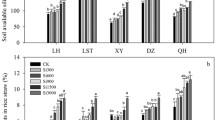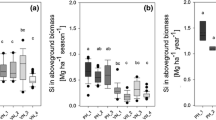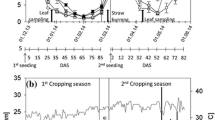Abstract
Background and aims
Rice plants (Oryza sativa L.) contain large quantities of silicon (Si) in form of phytoliths, which increase their resistance to abiotic and biotic stresses. The Si cycle through rice fields is hardly studied. We tested how increasing Si availability affects rice growth and the decomposability of the straw. Secondly we tested the role of straw recycling for Si availability.
Methods
In a field experiment, we applied three levels of silica gel during one rice cropping season. In a follow-up laboratory experiment, we used straw produced in the field experiment, having different Si concentrations, and studied straw decomposition, straw Si release, and Si uptake by plants.
Results
Silicon fertilization increased Si contents, biomass production, and grain yield of rice plants. Increased Si uptake by rice decreased concentrations of C and some essential nutrients (N, P, K, Ca, and Mg) in the straw, and increased straw decomposability and Si release.
Conclusions
Fertilization with silica gel is an option to improve Si supply to rice plants growing on weathered soils with low levels of plant-available Si. Phytoliths from fresh rice straw dissolve fast in soil, thus, recycling of rice straw is an important source of plant-available Si.





Similar content being viewed by others
References
Ackermann J, Vetterlein D, Tanneberg H, Neue H-U, Mattusch J, Jahn R (2008) Speciation of arsenic under dynamic conditions. Eng Life Sci 8(6):589–597
Aerts R (1997) Climate, leaf litter chemistry and leaf litter decomposition in terrestrial ecosystems: a triangular relationship. Oikos 79:439–449
Cooke J, Leishman MR (2011) Silicon concentration and leaf longevity: is silicon a player in the leaf dry mass spectrum? Funct Ecol 25:1181–1188
Cornwell WK, Cornelissen JHC, Amatangelo K, Dorrepaal E, Eviner VT, Godoy O, Hobbie SE, Hoorens B, Kurokawa H, Pérez-Harguindeguy N, Quested HM, Santiago LS, Wardle DA, Wright IJ, Aerts R, Allison SD, van Bodegom P, Brovkin V, Chatain A, Callaghan TV, Díaz S, Garnier E, Gurvich DE, Kazakou E, Klein JA, Read J, Reich PB, Soudzilovskaia NA, Vaieretti MV, Westoby M (2008) Plant species traits are the predominant control on litter decomposition rates within biomes worldwide. Ecol Lett 11:1065–1071
De Datta SK (1981) Principles and practices of rice production. International Rice Research Institute, Los Banos
Dobermann A, Fairhurst T (2000) Rice: nutrient disorders & nutrient management. International Rice Research Institute, Los Banos
Epstein E (1999) Silicon. Annu Rev Plant Biol 50(1):641–664
FAO (2006) Guidelines for soil description. Food and Agriculture Organisation of the United Nations, Rome
Fraysse F, Pokrovsky OS, Schott J, Meunier J-D (2009) Surface chemistry and reactivity of plant phytoliths in aqueous solutions. Chem Geol 258(3):197–206
Guntzer F, Keller C, Meunier J-D (2012) Benefits of plant silicon for crops: a review. Agron Sustain Dev 32(1):201–213
Haysom MB, Ostatek‐Boczynski ZA (2006) Rapid, wet oxidation procedure for the estimation of silicon in plant tissue. Comm Soil Sci Plant Anal 37(15–20):2299–2306
Hossain KA, Horiuchi T, Miyagawa S (2001) Effects of silicate materials on growth and grain yield of rice plants grown in clay loam and sandy loam soils. J Plant Nutr 24(1):1–13
IRRI (1997) IRRI Rice Facts. International Rice Research Institute, Los Banos
IUSS Working Group (2014) World reference base for soil classification 2014. World soil resources report 106. Food and Agriculture Organisation of the United Nations, Rome
Jones LHP, Handreck KA (1967) Silica in soils, plants, and animals. Adv Agron 19:107–149
Klotzbücher T, Kaiser K, Guggenberger G, Gatzek C, Kalbitz K (2011) A new conceptual model for the fate of lignin in decomposing plant litter. Ecology 92(5):1052–1062
Klotzbücher T, Marxen A, Vetterlein D, Schneiker J, Türke M, Sinh NV, Manh NH, Chien HV, Marquez L, Villareal S, Bustamante JV, Jahn R (2014) Plant-available silicon in paddy soils as a key factor for sustainable rice production in Southeast Asia. Basic Appl Ecol. doi:10.1016/j.baae.2014.08.002
Klotzbücher T, Leuther F, Marxen A, Vetterlein D, Horgan FG, Jahn R (2015) Forms and fluxes of potential plant-available silicon in irrigated lowland rice production (Laguna, the Philippines). Plant Soil. doi:10.1007/s11104-015-2480-y
Ma JF, Takahashi E (2002) Soil, fertilizer, and plant silicon research in Japan. Elsevier, Amsterdam
Ma JF, Tamai K, Yamaji N, Mitani N, Konishi S, Katsuhara M, Ishiguro M, Murata Y, Yano M (2006) A silicon transporter in rice. Nature 440(7084):688–691
Ma JF, Yamaji N, Mitani N, Tamai K, Konishi S, Fujiwara T, Katsuhara M, Yano M (2007) An efflux transporter of silicon in rice. Nature 448(7150):209–212
Parr JF, Sullivan LA (2011) Phytolith occluded carbon and silica variability in wheat cultivars. Plant Soil 342(1–2):165–171
Piperno DR (2014) Phytolyth analysis: an archaeological and geological perspective. Elsevier, Amsterdam
Raven JA (1983) The transport and function of silicon in plants. Biol Rev 58(2):179–207
Santos GM, Alexandre A, Coe HH, Reyerson PE, Southon JR, De Carvalho CN (2010) The phytolith 14C puzzle: a tale of background determinations and accuracy tests. Radiocarbon 52(1):113
Sauer D, Saccone L, Conley DJ, Herrmann L, Sommer M (2006) Review of methodologies for extracting plant-available and amorphous Si from soils and aquatic sediments. Biogeochemistry 80(1):89–108
Schaller J (2013) Invertebrate grazers are a crucial factor for grass litter mass loss and nutrient mobilization during aquatic decomposition. Fundam Appl Limnol 183:287–295
Schaller J, Struyf E (2013) Silicon controls microbial decay and nutrient release of grass litter during aquatic decomposition. Hydrobiologia 709(1):201–212
Schaller J, Hines J, Brackhage C, Bäucker E, Gessner MO (2014) Silica decouples fungal growth and litter decomposition without changing responses to climate warming and N enrichment. Ecology 95(11):3181–3189
Schmidt A, Auge H, Brandl R, Heong KL, Hotes S, Settele J, Villareal S, Schädler M (2015a) Small-scale variability in the contribution of invertebrates to litter decomposition in tropical rice fields. Basic Appl Ecol. doi:10.1016/j.baae.2015.01.006
Schmidt A, John K, Arida G, Auge H, Brandl R, Horgan FG, Hotes S, Marques L, Radermacher N, Settele J, Wolters V, Schädler (2015b). Effects of residue management on decomposition in irrigated rice fields are not related to changes in the decomposer community. PLoS ONE 10(7):e0134402. doi:10.1371/journal.pone.0134402
Schoelynck J, Bal K, Backx H, Okruszko T, Meire P, Struyf E (2010) Silica uptake in aquatic and wetland macrophytes: a strategic choice between silica, lignin and cellulose? New Phytol 186(2):385–391
Strickland MS, Osburn E, Lauber C, Fierer N, Bradford MA (2008) Litter quality is in the eye of the beholder: initial decomposition rates as function of inoculum characteristics. Funct Ecol 23(3):627–636
Watanabe T, Luu HN, Nguyen NH, Ito O, Inubushi K (2013) Combined effects of the continual application of composted rice straw and chemical fertilizer on rice yield under a double rice cropping system in the Mekong Delta, Vietnam. JARQ 47(4):397–404
Yamaji N, Ma JF (2009) A transporter at the node responsible for intervascular transfer of silicon in rice. Plant Cell 21(9):2878–2883
Acknowledgments
This work has been financed by the LEGATO project of the German Ministry for Education and Research (BMBF). We thank the coordinator of the project, Josef Settele, for his support. We thank Nguyen Hung Manh for the field work and Alexandra Boritzki, Aleksey Prays, Susanne Horka, Andreas Rämmler, Jutta Fröhlich, and Bernd Apelt for technical assistance. We thank the farmers for allowing us to establish the experiment on their paddies.
Author information
Authors and Affiliations
Corresponding author
Additional information
Responsible Editor: Jian Feng Ma.
Rights and permissions
About this article
Cite this article
Marxen, A., Klotzbücher, T., Jahn, R. et al. Interaction between silicon cycling and straw decomposition in a silicon deficient rice production system. Plant Soil 398, 153–163 (2016). https://doi.org/10.1007/s11104-015-2645-8
Received:
Accepted:
Published:
Issue Date:
DOI: https://doi.org/10.1007/s11104-015-2645-8




